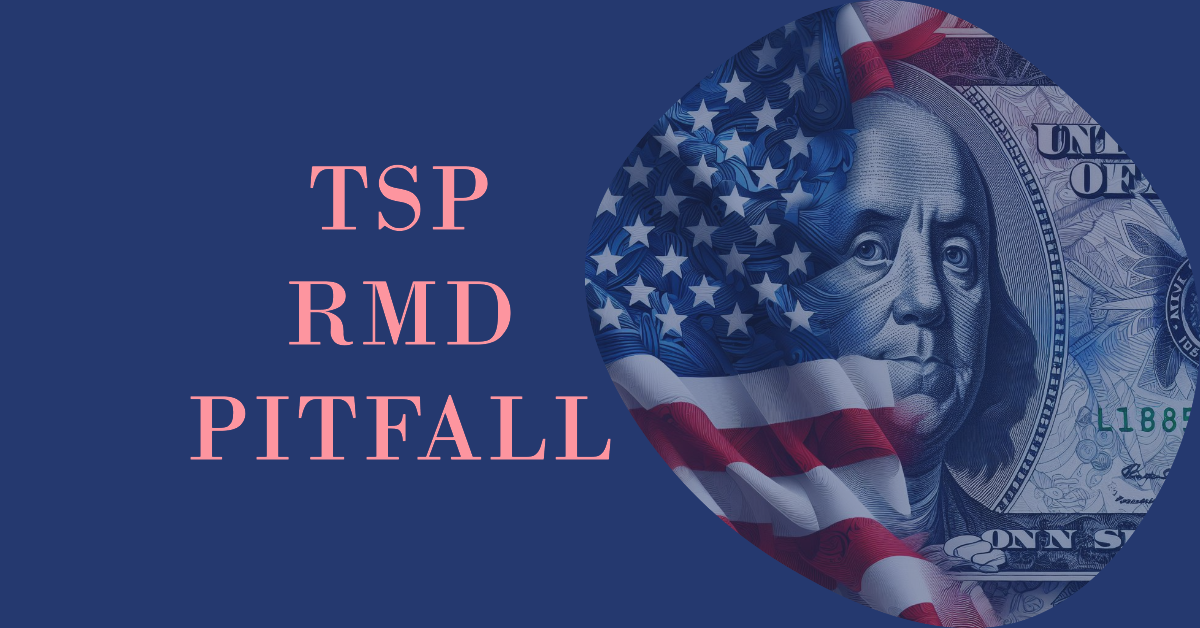Thrift Savings Plan RMD Pitfall: Why TSP Required Minimum Distributions Calculation Fails Some Couples
The Thrift Savings Plan has helped many federal families save for retirement. It is a good vehicle for building and accumulating assets with low-cost investment options and the federal government matching program. However, it has its challenges when it comes to retirement distributions. One of these is how it calculates the required minimum distribution for federal couples with an age gap.
Understanding Required Minimum Distributions (RMDs) in Retirement Plans
Most federal employees set aside tax-deferred retirement funds in the traditional TSP. You may also utilize an individual retirement plan (IRAs) such as a traditional IRA, SEP IRA, or rollover IRA. Regardless, as long as you have funds in a pre-tax retirement account, you should know that the IRS has set tax rules on the age to start withdrawals, subject to RMDs. It’s called Required Minimum Distributions, or RMD for short. The rules have changed since Secure Act 2.0. You have to start RMDs the year you turn 73. So, if you are bored in 1951 or later, you have hit your RMD age and must start the withdrawals this year. If you did not, the tax penalty is 25% of what you should have withdrawn. If this is your first year of RMD, you can delay that withdrawal until April 1st of the following year (2025). However, that means you will need to take out two withdrawals (the amount for 2024 and the amount for 2025).
Learn more about SECURE 2.0 big changes to retirement plans.
Note 1: Roth TSPs or Roth IRAs allow post-tax contributions and tax-free withdrawals, so they do not have withdrawal requirements.
Note 2: If you have multiple Traditional IRAs along with the TSP, you should note that the TSP RMD has to be taken from the TSP. You cannot take more from traditional IRAs to satisfy TSP RMD requirements.
How to Calculate the RMD
To calculate the RMD, you must know your end-of-year account balance, age, and the right IRS taxable amount for the prior year. Here is an example.
Bob is turning 73 this year (2024) and wants to fulfill his withdrawal obligation and avoid the tax penalty.
- He needs his traditional balance in his TSP for the prior year as of 12/31/2023, which is $500,000
- Then, he looked up the IRS Uniformed Lifetime Table and found his divisor number, which is 26.5
- To determine his RMD Amount, he takes $500,000 / 26.5 = $18,867.92
- He needs to withdraw the RMD amount by 12/31/2024. He can delay it until April 1 of the year 2025. However, that means he will need to take 2 RMDs in 2025
- He also needs to do the same thing if he has any other traditional money in IRAs or other eligible employer plans.
- He will repeat the process next year. Note that he will be one year older and needs to look up the new divisor number.
You can find the Life Tables on the official IRS Publication 590-B.
How Does TSP Handle Withdrawals in Retirement
The TSP has made great strides in flexibility in withdrawals. Retirees can use an automatic installment to pay themselves monthly, quarterly, or annually. Moreover, if you need additional funds, you can distribute them every 30 days from your TSP account. You can also separate traditional and Roth money from your TSP to take funds from each account. The TSP can also set up tax withholdings so some taxes can be paid to the Internal Revenue Service. So everything sounds great. What is the problem?
It concerns how the TSP will calculate installments based on life expectancy. If you have not reached your RMD age, the TSP will only use the Single Life Table, not the Uniform Table Above. Here’s the difference:
John, Age 70, decided to start payments based on his life expectancy. His Traditional TSP account balance is $500,000
- The divisor number for age 70 on the single life table is 18.8.
- The RMD amount would be $500,000 / 18.8 = $26,595.74. Much higher than the uniform amount
- The withdrawal percentage is 5.3%, much higher than the suggested 4% withdrawal rate.
Once John reaches 73, he can request the TSP to change the life expectancy table used. Before that, John needs to review his overall financial situation to see if single life-based withdrawals from his retirement savings make sense and if they can be sustainable throughout his retirement. For a deeper look at TSP withdrawals, check out TSP withdrawal options: installments, payments, and annuities.
The TSP Fails Couples With Age Differences Over 10 Years
For couples with an age gap over 10 years, you can use the joint life and last survivor expectancy table. The benefit is that the divisor number has the younger spouse’s age in mind, and the withdrawals will be less. Let’s say that we have a couple with a 15-year age difference. The older spouse reaches 73, and the younger spouse reaches 58. The divisor is 30.1. Then, in the same $500,000 example, the RMD will be $16,611.30. A lower amount compared to the Uniform tax table.
A smaller RMD means that you can withdraw less, pay less taxes, and allow more funds to grow tax-deferred.
How Can Federal Couples Take Advantage of the Joint-Life Expectancy Table
Couples can still take advantage of the joint tax table. To lower the required withdrawal, you need to roll over the traditional balance before the year you turn 73. Once the funds are out of the TSP and into a Rollover IRA, the TSP will no longer calculate the RMDs for you. You can request that your IRA custodian use the joint life expectancy table for RMD calculations. If you already reached RMD age, the TSP requires that you satisfy that year’s RMD with them. After that is done, you can roll over the remaining balance to a Rollover IRA.
Important Note: Once you move all the balance out of the TSP, the account will be closed, which will be an irrevocable decision. You should review this option carefully. Should You Transfer Out of Thrift Savings Plan (TSP)? Consider speaking to a CERTIFIED FINANCIAL PLANNER™ before making your decision.
Reach Out to Us!
If you have additional federal benefit questions, contact our team of CERTIFIED FINANCIAL PLANNER™ (CFP®), Chartered Federal Employee Benefits Consultants (ChFEBC℠), and Accredited Investment Fiduciaries (AIF®). At PlanWell, we are federal employee financial advisors with a focus on retirement planning. Learn more about our process designed for the career fed.
Preparing for federal retirement? Check out our scheduled federal retirement workshops. Sign up for our no-cost federal retirement webinars through our workshop page. Make sure to plan ahead and reserve your seat for our FERS webinar, held every three weeks. Want to have PlanWell host a federal retirement seminar for your agency? Reach out, and we’ll collaborate with HR to arrange an on-site FERS seminar.
Want to fast-track your federal retirement plan? Skip the FERS webinar and start a one-on-one conversation with a ChFEBC today. You can schedule a one-on-one meeting using our contact form.










